Who the Hell Was Jackie Jones and Why Is a Mountain Named for Him?
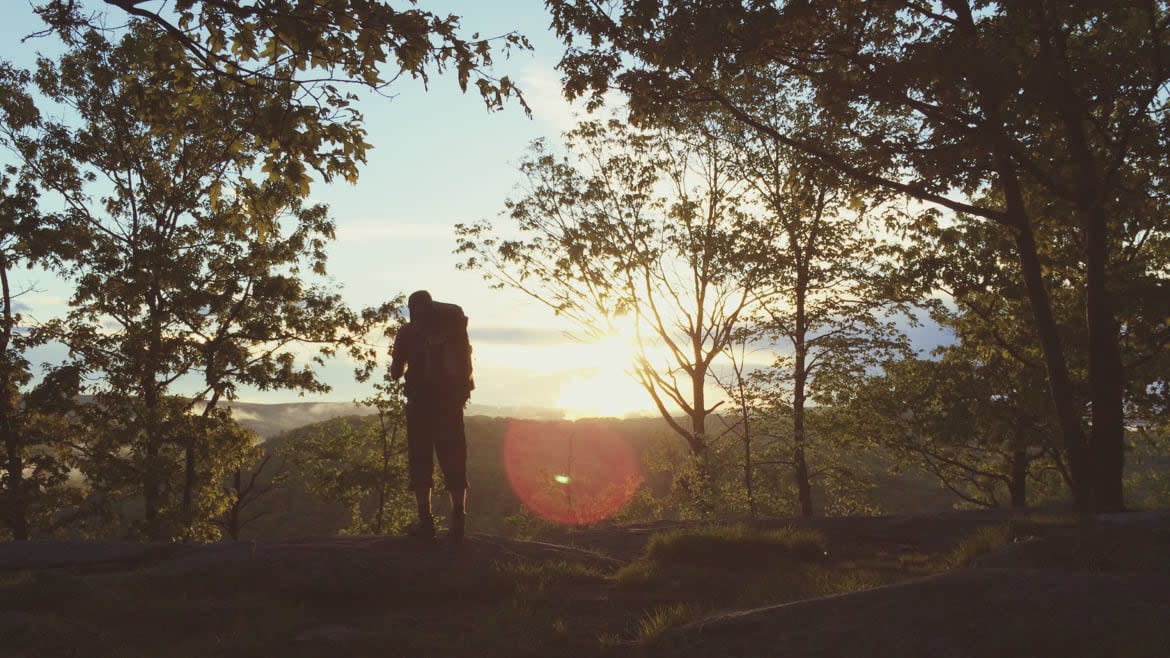
On June 23, 2020, I sent an email to Marianne B. Leese, the senior historian of the Historical Society of Rockland County.
I had what I hoped was an easy question to answer.
Who the hell was Jackie Jones?
Two days earlier, on the longest day of the year, I had ridden a bicycle over the newly opened bike path on Governor Mario M. Cuomo Bridge from my home in southern Westchester County.
After passing through Nyack and up to Haverstraw, I’d climbed up to Harriman State Park and rode nearly all the way to the top of a local peak. On foot, I’d climbed up to the top of a creaking old fire tower at the summit.
The view from on top of Jackie Jones Mountain was spectacular.
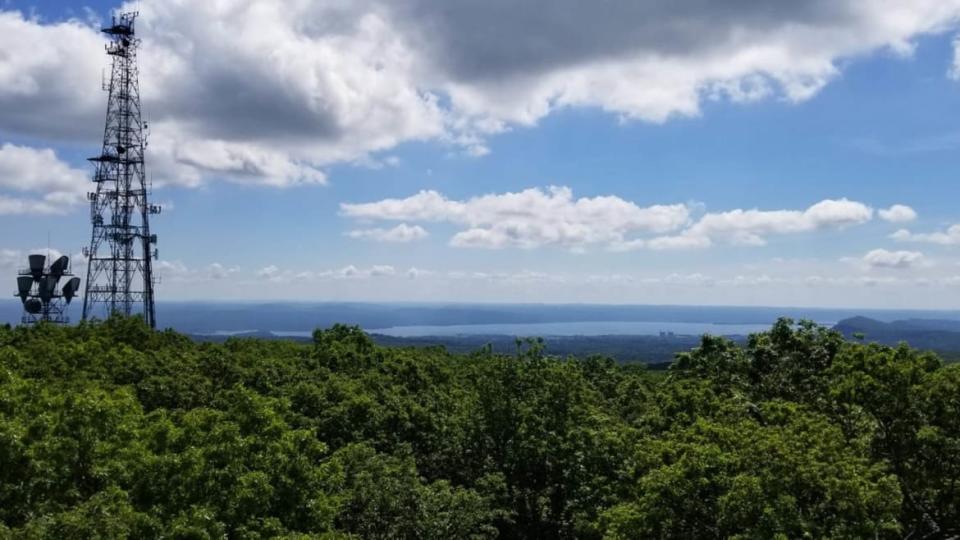
The year before, I’d noticed that an Arkansas man named Doug Melton, whose hobby is ascending county summits, had done an analysis of LIDAR data (laser ranging) and determined that for years the wrong peak had been designated the highest point in Rockland County.
With his analysis, Melton determined that Rockhouse Mountain was not 1,283 feet high, but only 1,271.95 feet, making it 5.55 feet lower than nearby Jackie Jones Mountain, at 1,277.5 feet.
A website called Peakbagger.com, a major arbiter for the country’s “high pointers,” made the change to its database. As far as Peakbagger was concerned, Jackie Jones Mountain was now supreme.
I'd recently begun my own pursuit of bagging county high points, but with a twist: riding there on a bicycle. I've ascended 20 of them, in New York, New Jersey, and Connecticut, including all five New York City boroughs in a single day’s ride.
But none of them provided such a breathtaking vista as Jackie Jones Mountain. And as I left to ride down the mountain and go the long way home over Bear Mountain Bridge, I couldn’t get one thought out of my mind.
Who was the mountain named after?
Initially, Ms. Leese said she couldn’t find anything in a book of history about the park, and when she checked with a former park employee who knew the area well, “He confirmed for me that no one knows who Jackie Jones was or how the mountain came to bear the name Jackie Jones.”
I turned to a New York state historian who was similarly stumped, but he was kind enough to check with his federal counterpart who pointed out that there was another peak a few miles away named Tom Jones Mountain. Perhaps there was a Jones family among local early settlers, he suggested.
On a website about the history of the nearby town of Stony Point, I found that a Jones family had been particularly prominent in the area. But nothing about a Jackie.
Several weeks later, Marianne Leese sent another message. She managed to find a 1992 document put out by the Palisades Interstate Park Commission that said the mountain had probably been named for a local resident, John R. Jones or his son John Jr., who had lived on the north side of the mountain in Sandyfield, a tiny hamlet that had been wiped out when a dam was built to create nearby Lake Welch in the 1940s.
Is Olana 19th Century America’s Greatest Work of Visual Art?
Now that I had a possible name, I was able to find more information about John R. Jones of Sandyfield.
He had been born in 1817 in Haverstraw or Stony Point, and had married Highlyann Babcock. When John was about 24 and Highlyann was about 20 they began having children. Adelia, Margaret, and William all grew into adulthood.
Their next child, Hiram, named after Highlyann's younger brother, was born in 1849 but died only a few years later, in 1853. Then they had Mary, John Jr., Harriet, Martha, and finally Sarah in 1862. Nine children over 21 years, and with 19th-century health care. They seemed fortunate to have lost only one of the nine while in childhood.
According to the 1992 document, cultivating the soil in Sandyfield was a tough prospect, subsistence farming that would have required other work to make life sustainable. At some point the Jones men had given it up and had taken up stone masonry. They became known locally for harvesting fieldstones that were used in construction, and examples of their work can still be found throughout the area.
Highlyann died in 1886, and John 10 years later, in 1896.
The first instance I could find in local newspapers of the name “Jackie Jones Mountain” occurred 31 years later, in 1927. But there was nothing in the 1992 article that explained how John R. Jones of Sandyfield had come to have the mountain named after him, or whether there was any evidence that he was known by that name.
And I soon found out I wasn’t the only person who had been looking for him.
In 2010, Alexandra Wren, then 19, went on a hike in Harriman State Park in search of her family’s past. Following a description in a newly published park guide, she hiked on a path called Beech Trail until she found a trailside cemetery.
Twenty years before, an eagle scout named Leroy Babcock Jr. had refurbished the forgotten little burial ground, repairing headstones and reinforcing them with metal frames. A small plaque bore witness to Leroy’s work.
The graves were of John R. Jones, his wife Highlyann, and their 3-year-old son Hiram. Nearby were the headstones of two Civil War soldiers and members of the New York 6th Heavy Artillery, known as the “Anthony Wayne Guard” after a local Revolutionary War hero: John Strickland, a father of eight who had died of typhoid fever in 1863 at 45, and his brother-in-law Timothy Youmans, who died at 35 on April 7, 1865, just two days before the end of the war. Timothy, I would learn, was Highlyann’s second cousin.
When she spotted the stones, Alexandra used her mobile phone to call her father, Gordon, who was busy working as Rockland County's director of Fire and Emergency Services.
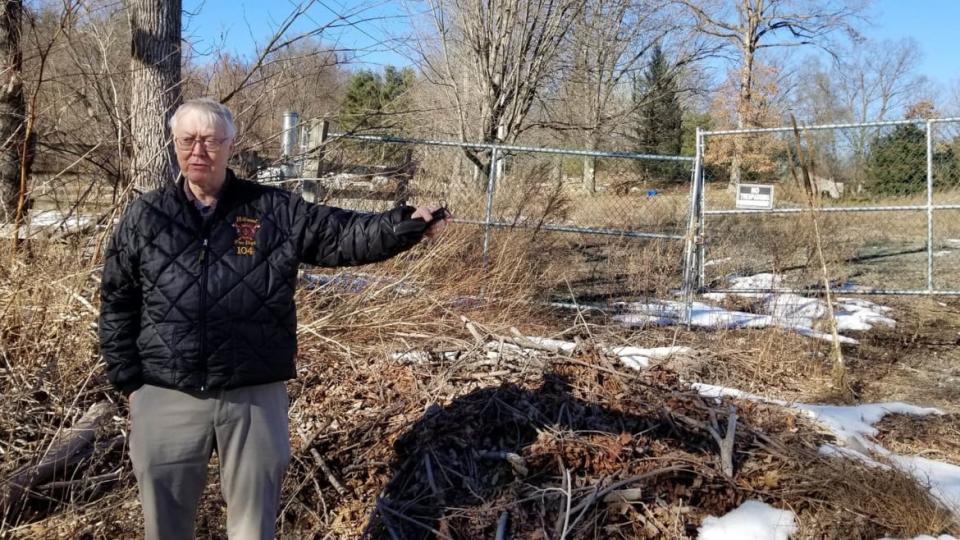
"Gordon Wren, standing where he did as a 20-year-old taking admission money to the fundraiser at Burgess Meredith's estate in 1966."
“ I hope this is important,” he told her.
“It is,” she said, and told him what she was looking at, the graves of John and Highlyann Jones.
He told her she was looking at her great-great-great-great-grandparents.
He told that story to the Genealogical Society of Rockland County in 2013, and it was reported in the Rockland County Times, which turned up on a search.
Gordon retired in 2018, but I found an email address for Alexandra, who is now 30 and runs a photography business. I sent her an email explaining my interest in her family history. Gordon then called me, and confirmed that John R. Jones, the Sandyfield farmer, was his great-great-great-grandfather. He believed that Jones was the Jackie Jones the mountain had been named after, although he had no documentation of it.
Gordon has lived in the area his entire life, and could still remember his older relatives, in the 1950s, speaking with a local mountain dialect. Back then, when the first bridge across the Tappan Zee was just being built, the differences between the two places, small Rockland County with its mountains and New York City to the south, were much more pronounced, and things that were unique about the area had not yet been lost.
Gordon worked in firefighting his entire career and became Rockland County’s chief fire instructor in 1977. He was named director of the county’s emergency services in 1995 and served in that role until his retirement.
I could hardly have found someone more rooted to Rockland County or more familiar with its every nook and cranny. Gordon was involved in local historical societies, and he led hikes through the backwoods.
He was anxious to share his own search for local history, and we bonded quickly over several phone calls discussing the mountain and his family.
A couple of weeks after I first made contact with him, I emailed Gordon with some news I'm sure neither one of us expected.
While continuing to search for some actual documentation providing a link between his great-great-great-grandfather and Jackie Jones Mountain, I had stumbled on a newspaper article in the Jan. 23, 1896, issue of the Rockland County Messenger.
It was about John R. Jones and how he had died.
“Whoa,” Gordon said when I told him about it.
According to the Messenger, in 1896 John R. Jones’s daughter, who lived with him, was becoming increasingly concerned about the state of his mind.
The article didn’t name the daughter, but his youngest, Sarah, would have been about 31 in 1896. John himself was 79. And his wife Highlyann would have been dead for 10 years.
It was January, and that means cold and dark days. John was acting strange, complaining that poverty was going to ruin them, when Sarah, if it was Sarah, knew that the family was actually doing fairly well. Her father owned two large farms and a woodland lot. Another daughter, living in Jersey City, was said to be worth $150,000.
On Wednesday, Jan. 15, John said he was losing his mind, and tried to give his daughter $15, telling her to go spend the winter somewhere else or she might not live through it. She refused.
The next morning, he asked her to go to Stony Point to take care of some business for him.
While she was gone, John R. Jones strung a rope from the rafters of his barn and hanged himself.
The housekeeper, a Miss Susie Topping, found him and fetched the neighbors.
“When the daughter came home she was overcome with the news that greeted her,” the Messenger reported.
An inquest found that it was suicide.
I could find no further mention of John R. Jones in local newspapers, and there was no mention that he had ever been known as Jackie, or that a mountain had been named after him.
He appeared instead simply to be a distraught and somewhat obscure 79-year-old local man who had sent his daughter away one January morning so he could end his life.
I was back at square one. Where did Jackie Jones Mountain get its name?
But then, another chance occurrence—stumbling upon another article in an old newspaper—made me realize that for some weeks now I’d simply been looking in the wrong place.
The answer to where the mountain had gotten its name was not on its north side, where Lake Welch was and the former village of Sandyfield. For the correct answer, I had to look south, to a small New York valley that had been saddled with an unseemly reputation.
The article I found was in a 1934 issue of the Rockland County Times, and it praised the work being done by local volunteer firefighters.
About halfway into the short article listing accomplishments by the local fire crews, there was this passage:
“The fire rangers under command of John Dempsey of Suffern met and conquered a forest fire Sunday that would have wiped out the Jackie Jones farm near Camp Hill, the property owned by the heirs of the late James A. Smith.”
Camp Hill was a reference to a protuberance that had obtained its name because Revolutionary War hero Anthony Wayne had camped his troops there after coming up from Haverstraw, the same Anthony Wayne that the 6th Heavy Artillery of Timothy Youmans and John Strickland had been named after.
The 1934 newspaper article suggested that near to Camp Hill there was a “Jackie Jones farm” that was well known enough that it still went by that name even after it had been acquired by a James A. Smith, who had passed it down to his heirs.
I sent the article to Marianne Leese, and she agreed that it was promising. She pulled out an 1876 map of Rockland County, and found that on an otherwise mostly empty parcel just north of Camp Hill, there was a lone house.
It was labeled “J.J. Jones.”
She then pulled up a current map and found that very close to that same location today there is a large, stately house that was listed as being built in 1865 (and was probably older, she said). Checking real estate listings, I found that the houses around it were all built in the 1970s and the 1980s, when the original farm had been subdivided.
The 1865 house seemed like it could very well have been the J.J. Jones house on the 1876 map, as well as the “Jackie Jones farm” mentioned in the 1934 article.
To confirm it, I began tracing ownership of the house from the current day back in time, grateful that Rockland County’s land records were relatively easy to access online.
Marianne, meanwhile, emailed me that she had managed to figure out the full name of the J.J. Jones listed on the 1876 map.
We seemed to be getting close.
“The worse place in the country,” the Rev. David Cole called it, writing in 1884 about a crossroads that was about halfway along the 14 miles between Suffern, a town on the New Jersey state line with belching ironworks, and Haverstraw, the port town on the Hudson.
In 1816, an enterprising nail cutter by the name of Michael Leyden, who also spelled his name Laden, realized that the midway point of that journey for the teamsters hauling goods back and forth between Suffern and Haverstraw would be a promising place to put a watering hole. His store and tavern also attracted mountain people who found that Laden was interested in their handmade products as payment for the food and drink he was selling. He took their handmade baskets and bowls so he could sell them in New York City. And although he left in 1836 to return to Manhattan, the crossroads had already taken on the name Ladentown and his tavern was already a local institution with an unsavory reputation.
“Sodom,” Cole says it was called by some.
Ladentown “was a favorite stopping place for teamsters on their journeys to and from the river; and as liquor could there be had in abundance, the village soon came to possess an unenviable reputation,” he wrote. But the good reverend assured his readers that by the time of his writing the hamlet “has long ere this outgrown its bad reputation.”
One way the locals took on Ladentown’s wide-open ways was to counter it by building a church. By 1865, Laden’s original property had been acquired by a man named John J. Secor, who set aside a parcel for the erection of the Methodist Episcopal Church.
Cole, in his 1884 History of Rockland County, not only lists the founders and original trustees of the church, crediting them with helping to clean up Ladentown, but also notes the institution's then current stewards, a D.D. Johnson, and a man who owned a large farm in the area about two miles to the northeast of the Ladentown crossroads.
His name was Jacob J. Jones.
It was Marianne who told me the name, and said the church steward in Cole’s history was the same J.J. Jones whose house was shown on the 1876 map.
We were now quickly putting together an outline of the farm’s history up to the present day.
Jones had acquired it at some point before 1865, and he had lived on it until he died the day after Christmas in 1908.
“Jacob J. Jones, perhaps one of the longest lived and best known residents of the Ladentown section, died at his home on Saturday last aged 83 years, 11 months and 14 days,” the Rockland County Times noted on Jan. 2, 1909.
As the 1934 newspaper article suggested, the Jacob Jones farm had eventually come into the possession of James A. Davis, the former manager of the West Shore Gas Company in Haverstraw, and a real estate investor whose holdings included the “Jacob Jones estate,” his obituary noted after he died suddenly on Aug. 2, 1933, at 74.
His wife Eleanor then sold the former Jacob Jones farm in 1936 to a woman named Lillie Mayer, who, with her husband Arthur, owned the farm for the next 30 years.
Arthur Mayer was a legendary film distributor who was so well known for his anecdotes about early Hollywood, he and Lillie spent much of the time in their later years touring colleges with their tales of movie lore. A short documentary was made about them, Arthur and Lillie, in 1975 and was nominated for an Oscar.
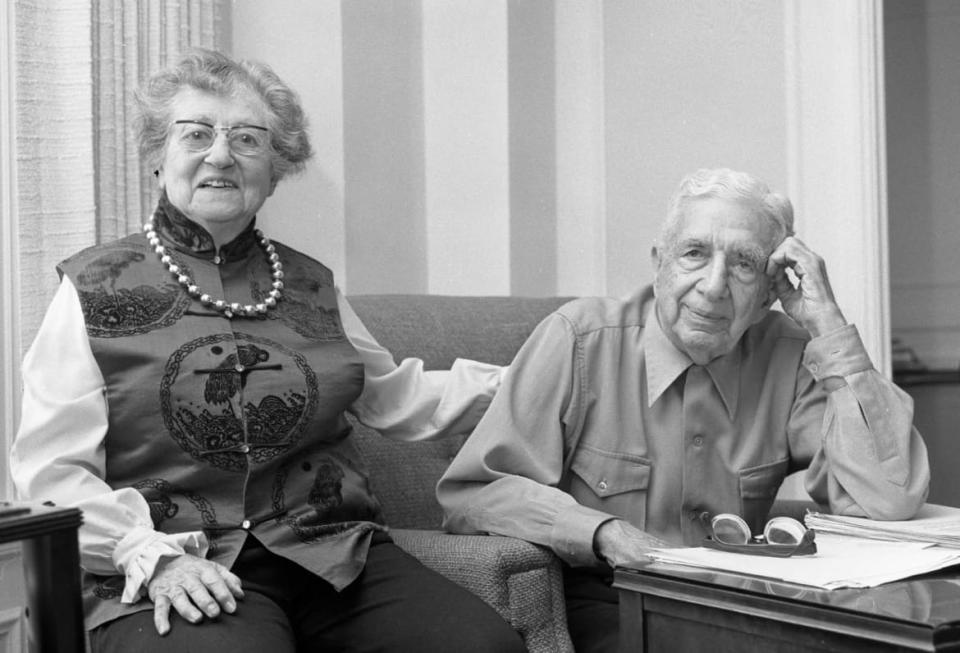
"Lillie and Arthur Mayer, who owned the Jackie Jones farm from about 1933 to 1978."
Two years before that, in 1973, Jane Lemkin went to meet Arthur and Lillie Mayer for the first time.
She had been told about them by a friend, who had house-sat the Mayer farm for several years. The Mayers were in New York City or lecturing at colleges most of the year, and they needed someone to live in the house year-round and keep it up. Her friend encouraged Jane to apply for the job, and she can still remember her first trip to the house, which at that time was surrounded by land, not other houses, and was quite secluded.
There was a swimming pool at that time built close to the house, and she was taken there for the interview.
“Arthur was sitting out there by the pool, stitch-stark naked. And he invited us to go in. So I took off my clothes and jumped in!” Jane told me with a laugh when I spoke to her on the telephone recently.
She remembers him cracking a joke about how her calves identified her as “good peasant stock.”
They got the job, and Jane says her children grew up in the house. After three years house-sitting for the Mayers, the house was sold to developer Vincent Giffuni, who asked them to stay in the house as he subdivided the farm, putting in new streets and houses. Finally, 15 years after that memorable interview by the pool, Jane’s family left the house in 1988.
“We loved it,” she says. “When we moved in, there was just this huge expanse of land. The house, the original part, had Dutch doors, and they told us the front door lock was from the old Rockland County jail. We would find things like bayonets on the property.
“It was paradise. We used to hike up to the top of Cheesecote Mountain,” Jane says. And she remembers that Arthur was angry that a communication tower had been built on top of it, which Arthur said was land he owned. “‘They didn’t ask me,’ he would say.”
Among the visitors to the house that Lemkin remembered were the Mayers’ grandchildren, including a young Shelley Mayer, who today happens to be my state senator.
As house-sitters, Jane’s family not only kept the house in shape but also the things in it, which included antique furniture, and also photo books, one of which included a snapshot of Eleanor Roosevelt in a white outfit at a lawn party at the house.
She says all of that was taken away in 1978, when Giffuni took possession of the house but continued to allow Jane to live there.
She remembers looking up the location of the house and seeing that it had previously been owned by a J.J. Jones, but she didn't know that the land had at one time been known as Jackie Jones Farm, and she didn't know if there was a connection to the mountain.
She agreed with Marianne Leese that the house was older than the 1865 date in real estate listings.
“The Mayers thought it went back to 1810,” she told me.
In 1941, five years after Lillie Mayer acquired the Jacob Jones farm, her husband Arthur signed a deal to distribute an unusual and controversial quasi-documentary put together by two of his Rockland County neighbors.
John Steinbeck lived for several years in the area, and the 1941 quasi-documentary The Forgotten Village was his attempt to portray a remote Mexican village that is dealing with a typhoid epidemic in a battle between traditional superstitions and modern medicine. The film used actual rural Mexicans as its cast, and the story is narrated in voiceover.
Steinbeck had originally wanted Spencer Tracy to do the narration, but MGM wouldn't let him out of his contract. So Steinbeck asked another Ladentown local to do the job: Burgess Meredith, who lived only about a mile from Arthur and Lillie Mayer, on Camp Hill Road.
Meredith had been lured to Rockland County by a playwright friend, Maxwell Anderson, who at one point in the 1930s was probably the most successful writer on Broadway. Anderson was inspired by Rockland’s geography, in particular the High Tor, a high point on the Palisades towering over the Hudson River that overlooks Haverstraw. In 1936 Anderson wrote a comic fantasy with that name about a contrary gadfly named Van Van Doren who owns the peak, which is also haunted by 16th century Dutch sailors. The play's original production opened that year in Cleveland with Burgess Meredith playing Van Doren.
“Hell, you don’t need money. Pap worked that out. All you need’s a place to sleep and something to eat. I’ve never seen the time I couldn’t find a meal on the mountain here, rainbow trout, jugged hare, something in season right around the zodiac,” Van Doren tells his sweetheart about how they can live on the mountain without money. (She remains understandably skeptical, so Van Doren, at least temporarily, throws her over for a Dutch ghost. It’s a quirky play.)
Three years later Meredith starred as George in the 1939 film version of Steinbeck’s Of Mice and Men. So they were already close friends when The Forgotten Village was made in 1941. The film ran into problems, however, when the state’s board of censors kept it from its scheduled opening in September for “indecent” and “inhuman” scenes that featured a mother breastfeeding and later while she is grimacing in childbirth.
Arthur Mayer appealed the ban and managed to get it lifted for a Nov. 18 opening at the Belmont Theater on 48th Street, to mixed reviews. But Steinbeck was always fond of it, despite the criticism.
“During my marriage to Paulette Goddard... I saw John Steinbeck often, and under happy conditions,” Meredith wrote in his 1994 memoir, So Far, So Good. “Paulette and I were living in my country house in Rockland County, twenty minutes north of the George Washington Bridge. The Steinbecks came to visit us there and we went to his home in Manhattan. During the postwar period, I witnessed the disintegration of his marriage to Gwyn and the growing up of his children. Later, he rented a country house near me, a fine hand-built home belonging to the artist Henry Varnum Poor.”
Meredith’s own marriage to Goddard ended in 1949. He married for the third time in 1950 to dancer Kaja Sundsten and continued to live just down the road from the Mayers.
By 1966, tensions over development in the area led local residents to incorporate as the village of Pomona. To help pay for the process, Burgess Meredith agreed to hold a fundraiser, a horse show, on his land.
At the base of the property, a gate still stands where people lined up to go inside for the show, and a 20-year-old local fireman was stationed there to make sure and get $10 from each of them, a large amount in 1966.
On a recent chilly March afternoon, Gordon Wren stepped over some dried branches and rocky ground in that same place in order to show me where he stood, taking money from people who had come to see the horse show on Burgess Meredith's property.
"I think I had only been a firefighter for about a year," Gordon said, remembering the details of that day for Marianne Leese and me as the three of us, after trading emails and phone calls for a few weeks, got together for the first time to look at some of the places we’d been researching.
"I was only 20, but they had me count the money," he said with a laugh. Meredith invited him up to the house and showed him into an upstairs room so he could have some quiet while he counted the day’s proceeds.
“He asked me if I wanted a drink. Then he brought me a rye and ginger in a giant tumbler. I said thank you, Mr. Meredith, and he said, ‘Don't call me mister!’ And he said when I was done, to come down to the pool for another drink.”
Gordon was still tickled about it, 55 years later.
With Marianne and Gordon, I went by the Mayer house, the Meredith house, and other landmarks in the Ladentown-Camp Hill area, including a mural at the local post office that depicts the area during the Revolutionary War.
I could tell that Gordon was disappointed that John R. Jones, his ancestor in Sandyfield, now seemed less likely to be the source of the mountain’s name. And Marianne, still mindful that the 1992 document suggested that John R. Jones was the source, asked me if I really had enough evidence to point instead to Jacob J. Jones of Camp Hill.
I laid out the case for her and Gordon.
The 1934 newspaper article called Jacob J.’s land the “Jackie Jones Farm,” and he was identified in Rev. Cole's 1884 book as a steward of the Methodist church which Cole credited with helping to improve the area's reputation. His obituary, meanwhile, had said he was one of the best-known figures in the area.
That all suggested to me the kind of person who might get a mountain named after him that was only three miles from the location of his farm.
Yes, the place where John R. Jones lived on the north side of the mountain, Sandyfield, was even closer to the peak. But his suicide, and the fact that very little else was known about him, and that there was no evidence tying him to the name “Jackie,” made it seem less likely that the landmark had been named after him.
But Marianne was right, there were still gaps in the story, despite what seemed like pretty good evidence that Jacob J. Jones, who had lived from 1825 to 1908 in the area that eventually became the village of Pomona, New York, with the help of Burgess Meredith’s 1966 fundraiser, was indeed the Jackie Jones whose name was on Rockland County’s highest peak.
We hadn’t been able to locate Jacob’s gravesite, which his obituary said had been near his homestead. (Jane Lemkin didn't remember any headstones near the house, and she suggested it might have been bulldozed with the subdivision of the farm.) There was a Jacob Jones whose grave was a little farther south, and that Gordon and I tracked down. But that Jacob had died in 1851, and wasn’t the person referred to in the 1934 newspaper article.
The current owner of the Jacob J. Jones/Lillie & Arthur Mayer house was at first excited to talk to me about the place, which he had bought in 2018. He said its original history went all the way back to 1760, and he had been restoring some of its original features. But then he stopped returning my calls, and so I thought it best to preserve his privacy.
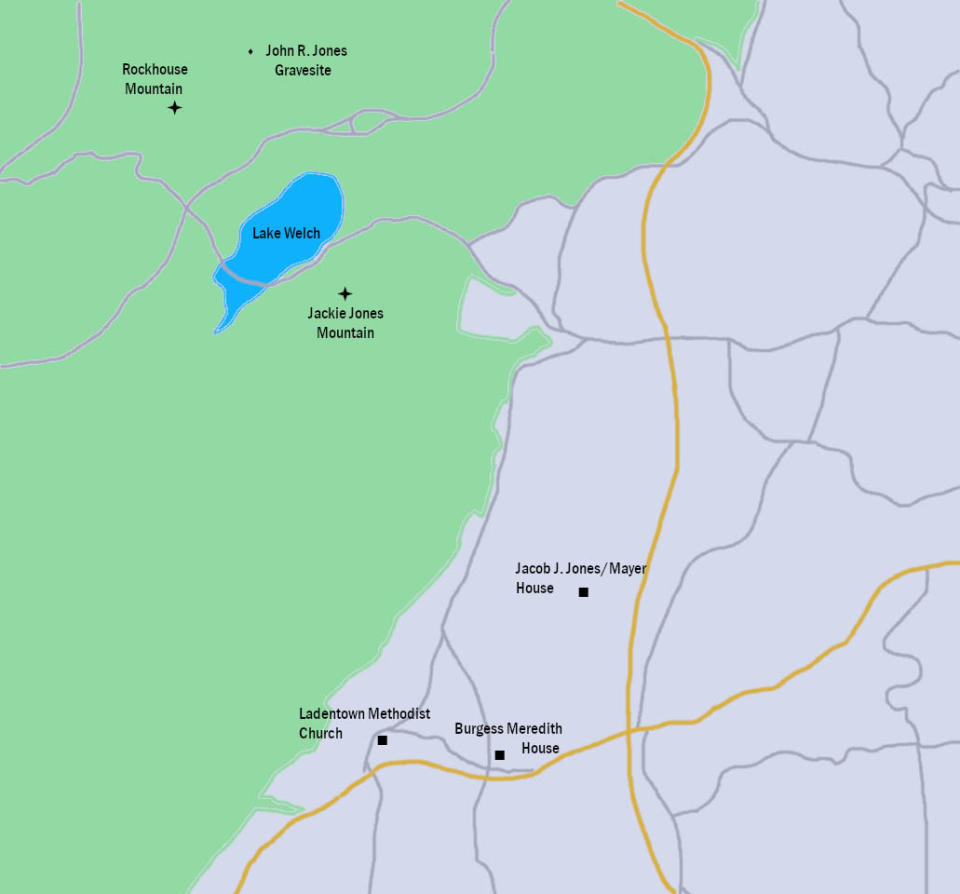
I wanted to know more, of course. And perhaps someday more information will turn up that helps explain how Jacob J. Jones of Camp Hill got a mountain named after him that now, thanks to Doug Melton, has taken its true place as a county’s highest point.
And another summer is coming. The bridge beckons. I figure I’ll ride back to Rockland County and up to Lake Welch and hike the Beech Trail, this time not with the goal of standing on a peak, but so I can visit John, Highlyann, Hiram, and their cousins Tim and John. And then swing down to Burgess Meredith Park in Pomona.
I hope Gordon is up for a tumbler of something if I happen to swing by.
Get our top stories in your inbox every day. Sign up now!
Daily Beast Membership: Beast Inside goes deeper on the stories that matter to you. Learn more.

